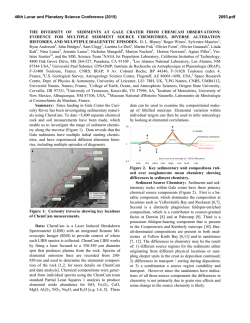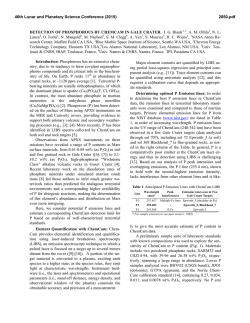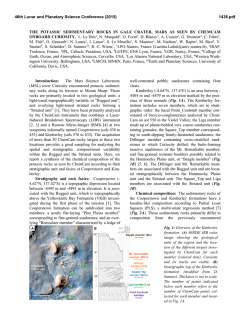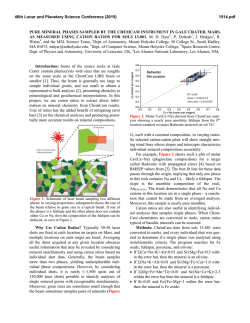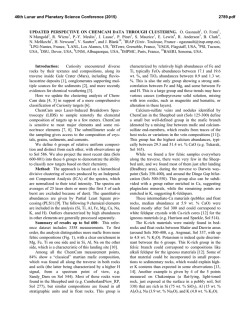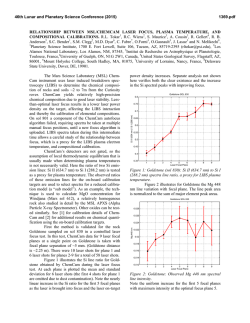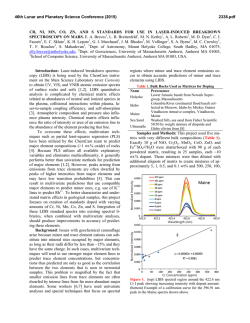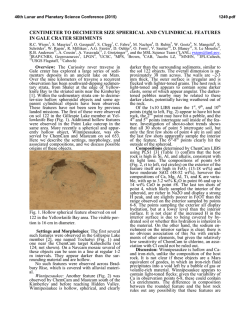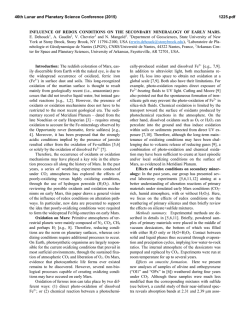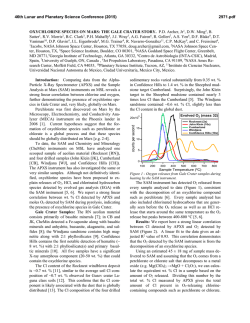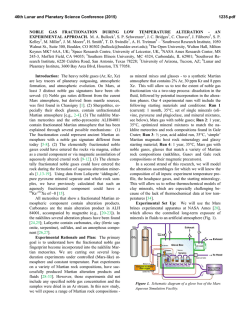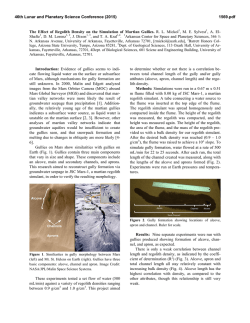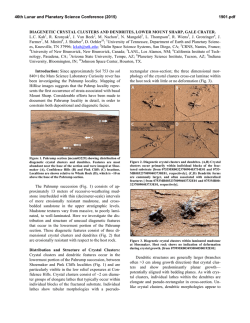
PAST? - USRA
46th Lunar and Planetary Science Conference (2015) 2893.pdf OXIDATION OF MANGANESE AT KIMBERLEY, GALE CRATER: MORE FREE OXYGEN IN MARS’ PAST? N.L. Lanza ([email protected])1, R.C. Wiens1, R. E. Arvidson2, B.C. Clark3, W.W. Fischer4, R. Gellert5, J.P. Grotzinger4, J.A. Hurowitz6, S.M. McLennan6, R.V. Morris7, M. S. Rice8, J.F. Bell III9, J.A. Berger10, D.L. Blaney11, J.G. Blank12, 13, N.T. Bridges14, F. Calef III11, J.L. Campbell5, S.M. Clegg1, A.Cousin1, K.S. Edgett15, C. Fabre16, M.R. Fisk17, O. Forni18, J. Frydenvang19, K.R. Hardy20, C. Hardgrove9, J.R. Johnson14, L.C. Kah21, J. Lasue18, S. Le Mouélic22, M.C. Malin15, N. Mangold22, J. Martìn-Torres23, 24, S. Maurice18, M.J. McBride15, D.W. Ming7, H.E. Newsom25, S. Schröder18, L.M. Thompson26, A.H. Treiman27, S. VanBommel5, D.T. Vaniman28, and M.-P. Zorzano29. 1Los Alamos National Laboratory, Los Alamos, NM, U.S.A. 2Washington University in St. Louis, St. Louis, MO, U.S.A. 3Space Science Institute, Boulder, CO, U.S.A. 4California Institute of Technology, Pasadena, CA, U.S.A. 5University of Guelph, Guelph, Ontario, N1G 2W1, Canada. 6Stony Brook University, Stony Brook, NY, U.S.A. 7NASA Johnson Space Center, Houston, TX, U.S.A. 8Western Washington University, Bellingham, WA, U.S.A. 9Arizona State University, Tempe, AZ. 10University of Western Ontario, London, Ontario, N6A 5B7, Canada. 11Jet Propulsion Laboratory, Pasadena, CA, U.S.A. 12NASA Ames, Moffett Field, CA, U.S.A.13Blue Marble Space Institute of Science, Seattle, WA, U.S.A.14APL, Johns Hopkins University, Laurel, MD, U.S.A. 15Malin Space Science Systems, San Diego, CA, U.S.A. 16Université de Lorraine, Nancy, France. 17Oregon State University, Corvallis, OR, U.S.A. 18Institut de Recherche en Astrophysique et Planétologie (IRAP), Toulouse, France. 19Niels Bohr Institute, University of Copenhagen, Copenhagen, Denmark. 20U.S. Naval Academy, Annapolis, MD, U.S.A. 21University of Tennessee Knoxville, Knoxville, TN, U.S.A. 22LPGNantes, CNRS UMR 6112, Université de Nantes, Nantes, France. 23Instituto Andaluz de Ciencias de la Tierra, Granada, Spain. 24Luleå University of Technology, Kiruna, Sweden. 25University of New Mexico, Albuquerque, NM, U.S.A. 26Univeristy of New Brunswick, New Brunswick, Canada. 27Lunar and Planetary Institute, Houston, TX, U.S.A. 28Planetary Science Institute, Tucson, AZ, U.S.A. 29Instituto Nacional de Técnica Aeroespacial, Madrid, Spain. Introduction: High Mn concentrations provide unique indicators of water-rich environments and their redox states. Very high-potential oxidants are required to oxidize Mn to insoluble, high-valence oxides that concentrate Mn in rocks and sediments; these redox potentials are much higher than those needed to oxidize Fe or S. Consequently, Mn-rich rocks on Earth closely track the rise of atmospheric oxygen [1-4]. Given the association between Mn-rich rocks and the redox state of surface environments, observations of anomalous Mn enrichments on Mars raise similar questions about redox history, solubility and aqueous transport, and availability as a metabolic substrate. Our observations suggest that at least some of the high Mn present in Gale crater occurs in the form of Mn-oxides filling veins that crosscut sandstones, requiring postdepositional precipitation as Mn(II)-bearing fluids became oxidized as they moved through the fractured strata after their deposition and lithification, allowing Mn-oxides to precipitate. High manganese observations: Three rock tar- gets in the Dillinger member of the Kimberley waypoint were found to have Mn concentrations highly elevated above those of average martian crust and other rocks of the same member: Stephen (sols 611, 619, 630), Neil (sol 619), and Mondooma (sol 625) (Fig. 1) [5]. All of these targets sample resistant fracture fills that crosscut this member. ChemCam manganese abundances at Stephen, Neil, and Mondooma show average MnO abundances of 5.2 wt% (Stephen), 5.3 wt% (Neil), and 6.7 wt% (Mondooma). Alpha Particle X-Ray Spectrometer (APXS) measurements on Stephen show an average MnO abundance of 3.7 wt%, the highest Mn abundance observed by this instrument in Gale crater to date. The average Mn values from both instruments are well above typical martian igneous values of ~0.4 wt% MnO [6]. Trends with depth: Mn abundance in ChemCam sampling locations was greatest in the first post-dust shots of the series and systematically decreased with succeeding shots (i.e. depth) (Fig. 2), with a maximum of ~35 wt% MnO on Mondooma location 1, shot 4. Fig. 1. Targets at Kimberley containing elevated Mn. (A) Overview of the Windjana drill site showing targets Stephen and Neil (MCAM 0626ML0026760010302385E01). (B) Closeup of Stephen showing a dark material beneath the surface dust layer; this target was analyzed by both ChemCam and APXS. Note that the ChemCam analysis locations are visible as small, rounded pits in the rock surface (MAHLI 0627MH0004070000203592R00). (C) The Mondooma target is a fin-like, more resistant feature that stands out from the surrounding outcrop; the highest single-shot Mn detection at Kimberley was found in this target (~35 wt% MnO) (MCAM 0626MR0026790000401609E01). 46th Lunar and Planetary Science Conference (2015) Fig. 2. Mn abundance decreases with depth (shot number) in ChemCam data obtained on the target Stephen (619). These results are consistent with a thin layer containing elevated Mn that was deposited adjacent to the Windjana outcrop material. Geochemical trends: In ChemCam data, Si and Ca are inversely correlated with Mn, suggesting that the high Mn phase is not a silicate and does not contain abundant Ca. ChemCam did not detect Cl or S in the three high Mn targets; this along with the absence of C above atmospheric levels demonstrates that Mn is not present as a sulfate, chloride, or carbonate phase. The APXS composition of Stephen is generally similar to the Windjana bedrock except for elevated abundances in Mn, Mg, Cl, Ni, Cu, Co, and Zn; however, of the elements showing enrichment, only Ni and Cu show a strong correlation with Mn. These trends imply the presence of Mn-oxides, which are well known to scavenge trace metals from water [7,8]. Passive reflectance spectra of Stephen show it has very dark surface, similar to laboratory measurements of Mn-oxides [5, 9]. Implications for the martian environment: The presence of likely Mn-oxides has important implications for the past redox conditions of Gale groundwater and the martian atmosphere. Very high potential redox reactions are needed to oxidize Mn2+ at circumneutral pH (>>500 mV), which requires either O2 or species derived from O2 (e.g. reactive oxygen species). The subsurface geological setting of the fractures rules out photooxidation as a mechanism for oxidation. Oxychlorine species have been detected by the Sample Analysis at Mars (SAM) instrument in solid samples throughout the rover’s traverse [10-12], some of which can have high enough redox potentials to oxidize Mn(II) [13]. However, none of these oxychlorine detections were associated with Mn enrichments, despite thorough analysis by the CheMin, APXS, and ChemCam instruments [14-17]. Accordingly, we hypothesize that Mn(II)-bearing fluids encountering O2 (or species derived thereby) provides the most reasonable pathway to Mn oxidation and enrichment. On Earth, O2 is present in groundwaters due to interaction and equilibrium with the atmosphere. Due to 2893.pdf the extremely slow kinetics of Mn oxidation, either concentrations of martian atmospheric O2 were much higher in the past than observed today or the timescale for water flowing through these fractures were remarkably long (Fig. 3). Oxidation in a long timescale, low O2 aqueous environment is a less favorable model because chemical weathering in this environment is expected to remove O2 from fluids, making them more reducing rather than more oxidizing over time. Our results suggest that the fluids moving along Kimberley fractures were in at least partial contact with the atmosphere and that the atmosphere contained sufficient amounts of O2 to oxidize Mn. Additionally, the discovery of Mn-oxides at the rim of Endeavor crater [18] suggests that the conditions required to concentrate and deposit Mn were present well beyond Gale crater. 5 mM Mn2+, Fe2+ pH 8 Fig. 3 . Characteristic half-lives for the kinetics of Mn oxidation by O2 in terms of terrestrial present-day O2 levels (PAL) for both homogenous oxidation from solution (upper black line) and typical surface-catalyzed oxidation by metal oxides (lower black line), with Fe oxidation by O2 for comparison (red line). References: [1] Johnson, J.E. et al. (2013). Proc. Natl. Acad. Sci. 110 (28), 11,238-11,243. [2] Maynard, J.B. (2010). Econ. Geol. 105, 535-552. [3] Hazen, R.M. et al. (2008). Amer. Min. 93, 16931720. [4] Kirschvink, J.L. et al. (2000). Proc. Natl. Acad. Sci. 97 (4), 1400-1405. [5] Lanza et al., submitted. Nat. Geosci. [6] Taylor, S.R. and McLennan, S.M. (2009). Cambridge University Press: New York, 378 p. [7] Goldberg, E.D. (1954). J. Geol. 6 (3), 249-265. [8] Sorem, R.K. (1989). Marine Mining 8 (2), 185-200. [9] Hardgrove, C. et al. (2015). LPSC XLVI, this issue. [10] Glavin, D.P. et al. (2013). J.Geophys. Res. Planets 118, 1955-1973. [11] Leshin, L.A. et al. (2013). Science 341, doi:10.1126/science.1238937. [12] Ming, D.W. et al. (2014). Science 343, doi:10.1126/science.1245267. [13] Sellers, K. et al. (2007). Perchlorate: Environmental Problems and Solutions, 1st ed., 226 pp., CRC Press, Boca Raton, FL. [14] McLennan S.M. et al. (2014). Science 343, doi:10.1126/science.1244734. [15] Blake, D.F. et al. (2013). Science 341, doi:10.1126/science.1239505. [16] Vaniman, D.T. et al. (2014). Science 343, doi: 10.1126/science.1243480. [17] Blaney, D.L. et al. (2014). J. Geophys. Res. Planets 119 (9), 2109-2131. [18] Arvidson et al., submitted. Nat. Geosci.
© Copyright 2025
